
The Deuteron
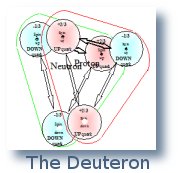
As shown in the previous section a proton and neutron can form a deuteron by stacking their three quark structures one on top of the other in a configuration that aligns the electric charges for maximum and optimum attraction.

In a proton the two up quarks are positioned so their magnetic dipoles form a magnetic loop. This aligns the up quarks magnetic dipoles and spins in opposite directions. The macro equivalent is similar to clamping two bar magnets together.
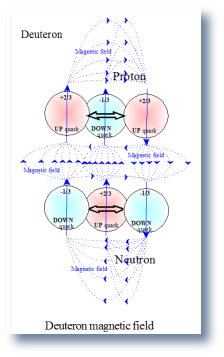
The neutron's two down quarks overlaps the proton's two up quarks so that all four magnetic dipoles are coupled. That leaves the single down quark in the proton align with the single up quark in the neutron. All the electric and magnetic dipole fields are thus configured for maximum coupling for the deuteron. Even so the magnetic dipoles are not canceled and spin is not balanced.
The deuteron contains two nucleons with six quarks, three up and three down, and in this configuration which has an odd number of protons of protons and neutrons the spins and magnetic dipoles are not totally offset. Thus, the deuteron has a residual magnetic dipole and a spin of 1.
Pictured in here are three models representing the deuteron.
- The first, above, is an illustration showing an adjacent proton and neutron with the up and down quarks coupled with each other.
- The second to the right shows the magnetic field associated with this configuration of the deuteron.
- The third to the right is a physical model of the deuteron,
highlighting the quarks, using ZOME constructs.
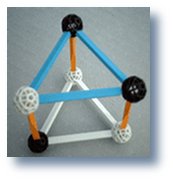
- The black nodes represent up quarks.
- The white nodes represent down quarks.
- The nodes connected with blue struts represent a proton.
- The nodes connected with white struts represent a neutron.
- The yellow struts used here represent the electrical cross connections between the quarks from proton to neutron.
There are several ways to visualize the deuteron forming during the building of heavier nuclei. Each has a different energy and different stability. However, during growth of heavier stable nuclei, less stable forms of the deuteron may be more advantages at different steps or phases of the stable nuclei building process. Even so for the proton and neutron that forms the deuteron, it is the first arrangement of quark coupling that was described first is by far the most stable.
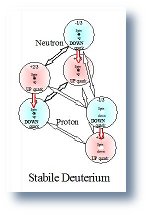
The different configurations of a protons and a neutron that form a deuteron can be classified by how stable the configuration will be. The first configuration of the deuteron is the lowest energy level but highest binding energy because it is formed by stacking the three quark structures of the proton and neutron on top of each other which forms three stable electrical bonds, see the figure to the left. In this form there is also maximum magnetic coupling of the magnetic fields. The stable configuration positions protons with two up quarks so their magnetic dipoles are opposite each and aligned with the two down quarks of the neutron positioned so all the magnetic dipoles are coupled and their electric fields are also coupled. This leaves the down quark in the proton aligned with the up quark in the neutron. This arrangement places the electric charges of the quarks and the magnetic dipole of the quarks in a configuration of maximum coupling.
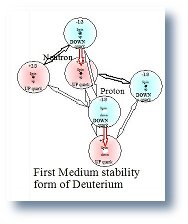
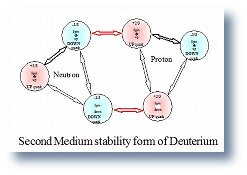 Configuration two the next lowest energy configuration shown to the
left is formed by the two up quarks of the proton laying over the two
down quarks of the neutron, or the form where the two up quarks of the
proton laying side by side with the two down quarks of the neutron. The
magnetic field and the electric fields couple in both of these cases,
however the extra up and down quarks that are not coupled result in
instability.
Configuration two the next lowest energy configuration shown to the
left is formed by the two up quarks of the proton laying over the two
down quarks of the neutron, or the form where the two up quarks of the
proton laying side by side with the two down quarks of the neutron. The
magnetic field and the electric fields couple in both of these cases,
however the extra up and down quarks that are not coupled result in
instability.
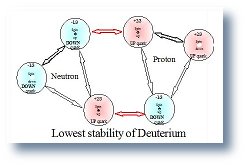
Configuration three is formed by a over under and side by side arraignment where an up down pair of quarks of the proton is positioned next to a down up pair of quarks from the neutron. These forms are very unstable but they could exist for some time.
Configuration 2 and 3 occur regularly in various stages of nucleus formation between complete nuclear stages
The tritium and helium 3 nucleus will be considered later but it is essential to examine the helium 4 nucleus or alpha particle first.